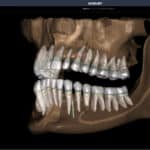AI is rewriting the rules of online visibility and changing how patients find you. Is your practice ready?
By Amy Epstein, MBA
For years, orthodontic practices followed a familiar digital marketing playbook when it came to search results. Patients might search for “best orthodontist near me” or something similar, browse the results, and click through to a practice’s website to gather information. If you had a well-optimized website with the right keywords, you had a good chance of appearing near the top—and earning that click.
But this method of practice discovery and research is being deprioritized as AI summaries are beginning to supplant traditional search results on popular search engines.
Artificial intelligence is transforming how people find, evaluate, and choose providers. The traditional search engine model, where users scroll through a list of results, is being replaced by AI-driven search experiences that deliver curated, personalized answers—often without requiring a single click, providing a map to each result that bypasses direct interaction with your online marketing but is influenced by it. Online review sites, Google’s AI Overviews, Apple’s AI-powered Siri, and social media search algorithms are beginning to filter and summarize information, making decisions on behalf of the searcher.
For orthodontic practices, this shift changes everything. It is no longer enough to simply have your website’s content rank well on Google for your priority keywords. AI might decide which practices deserve to be highlighted and what information potential patients see. Orthodontists who strategically adapt will remain in front of their audience. Those who continue to rely only on traditional search strategies risk being pushed farther down the results page.
How AI Determines Which Practices Get Visibility
AI doesn’t just pull names from a directory; it ranks and selects orthodontic practices based on multiple factors, including their Google Business Profile activity, third-party reviews, website content quality and relevancy, and your social media presence. Yes, this sounds similar to traditional SEO but the difference is the AI filtering.
For example, a parent searching for “how long will my child need to wear braces” may no longer see a traditional list of search results. Instead, AI-powered tools like Google’s AI Overviews may generate a summarized answer at the top of the page, pulling from a variety of credible sources—including orthodontic websites. These summaries often include links back to the original pages, meaning that if your website features well-structured, informative content on topics like treatment timelines, AI may reference it directly.
That means your website isn’t just a marketing tool—it’s a potential source of authority in how AI responds to patient questions. When done right, your content can earn trust not just from visitors, but from the AI itself.
But what happens when a patient’s question is more subjective—like “best orthodontist near me”?
We’re not quite at the point where every subjective search generates a full AI overview, but the landscape is shifting quickly. New search platforms powered by large language models (LLMs), like Perplexity and ChatGPT’s evolving search experiences, are already delivering conversational summaries instead of traditional lists of blue links. While Google and Bing still dominate, these emerging tools offer a glimpse into how the definition of “best” is being redefined by AI—and how that will eventually impact larger, mainstream platforms.
So what does “best” mean in an AI-powered search experience? In the past, it was often determined by SEO: practices that used the right keywords, backlinks, and page structure could outrank competitors regardless of actual quality of care or reputation. But in an AI-driven model, “best” is increasingly based on data that spans your entire digital presence. AI considers review sentiment, content clarity, relevance, social engagement, and structured data to make its determination. What your website says, how your patients describe you, and how consistently you appear across platforms—all of it shapes whether AI will showcase your practice when someone types in a phrase like “best orthodontist near me.”
The result? Visibility isn’t just earned through optimization alone—it’s earned through trust, authority, and engagement. In this AI-curated future, those qualities need to be consistently reflected across all your digital touchpoints. A strong local SEO strategy will still play a key role—but it’s just one piece of a much bigger puzzle. You need a holistic digital strategy to compete moving forward.
The AI Content Controversy: Who Controls Your Visibility?
New tech always comes with new controversy. While AI-driven search engines claim to enhance user experience, they are also raising serious concerns about who benefits from this shift in power. Large AI companies, including Google and OpenAI, have been accused of using online content without permission to train their models—pulling information from websites, reviews, and even patient testimonials to generate their own AI-curated answers.
This raises an urgent question: What happens when AI uses an orthodontist’s content to inform patients, but users no longer need to visit the practice’s website to get answers? Tools like Google’s AI Overviews and ChatGPT’s Browse often provide clickable citations or an expanded summary that links back to the original sources—but that doesn’t guarantee traffic. In many cases, users are satisfied with the AI’s answer and never click through. As search behavior shifts from “click-based” to “summary-based,” orthodontic websites must now compete not just for rankings, but for inclusion as a trusted source in the AI’s response itself.
Lawsuits are already underway. The New York Times has sued OpenAI for scraping its articles without compensation. Chegg, an online education company, is suing Google, arguing that AI Overviews eliminated the need for students to visit its site, leading to a catastrophic drop in traffic.
Orthodontic practices face a similar challenge. What if AI continues to scrape and summarize information without attribution? In this new landscape, having a strong website is important but can’t be the sole focus—practices must ensure their digital presence is fully optimized and holistic enough to be captured by AI-driven results by diversifying their marketing channels, strengthening their authority across multiple platforms, and creating content designed for AI-driven search. This way “best orthodontist near me” will result in your practice showing up in an AI-generated search result and not your better-prepared competitor.
Content Quality and Engagement: AI Rewards Authority
AI search tools prioritize well-written, authoritative content over keyword-heavy pages. When we think about SEO in its current form at People + Practice, we already think in terms of context to relatable and authoritative content, we already think about answering patient questions clearly and comprehensively, ensuring AI sees them as valuable sources.
Instead of writing for Google’s old ranking algorithms, content must be structured for human engagement—because AI tools pull from the most informative, easy-to-understand sources when generating their own answers.
For orthodontic practices, this means:
- Providing in-depth answers to common questions about treatment options, pricing, and procedures.
- Using structured content with clear headings and FAQs, making it easy for AI to extract relevant information.
- Adding high-quality media, including patient testimonials, graphics, and educational content that AI models recognize as valuable.
Websites that fail to evolve beyond traditional SEO might be left behind by AI search models—meaning their content won’t appear in AI-generated responses, even if they rank well organically. Your approach to marketing must evolve and must be holistic.
Reputation Management: More Important Than Ever Before
Patient reviews have always been critical but now AI is analyzing and moderating them in ways that impact search visibility. High-quality reviews not only enhance a practice’s credibility but also play a pivotal role in local SEO rankings. According to Google’s guidelines, “Google review count and score are factored into local search ranking: more reviews and positive ratings will probably improve a business’s local ranking.”
The impact of reviews extends beyond search algorithms; they directly affect consumer behavior too. A study highlighted that 98% of people read online reviews to guide their purchase decisions, underscoring the importance of maintaining a positive online reputation. Moreover, businesses that actively engage with reviews—responding to both positive and negative feedback—demonstrate a commitment to customer satisfaction, which further enhances trust and can lead to increased patient inquiries.
Recognizing the critical role of reviews, People + Practice offers PatientCue, a comprehensive service designed to facilitate the collection and management of patient feedback. This system automates the process of requesting feedback through emails and text messages following patient visits. Additionally, in-office posters featuring QR codes direct patients to a feedback form accessible via their smartphones, simplifying the review process. Our PatientCue system intelligently routes feedback based on its nature, directing unhappy patients back to the doctor, enabling swift action to address concerns and mitigate potential issues before they become public.
By proactively managing patient reviews, orthodontic practices can strengthen their online presence, build trust with potential patients, and improve their search engine rankings as well as AI-driven results, ultimately leading to practice growth and success.
The Downside: AI Reads and Sometimes Removes Reviews
Recently, a widespread Google Business Profile issue caused review counts to drop—even though the reviews themselves were still intact. While Google later confirmed this was a display error, the immediate impact was clear: Practices appeared to have fewer reviews, potentially affecting patient trust and AI-generated rankings.
At People + Practice, we identified the issue early and took swift action. We audited every client’s profile, determined the level of impact, and submitted detailed reports to Google, ensuring our clients were added to their initial Escalation List for priority resolution. Once the issue was resolved, we provided timely updates to all affected clients. This situation highlights a critical reality: AI moderation is not perfect, and orthodontic practices must actively manage their online reputation. By taking a hands-on approach—monitoring reviews, escalating issues, and ensuring online accuracy—practices can safeguard their visibility and credibility in an AI-driven world.
To stay ahead, orthodontic practices must:
- Encourage detailed patient reviews that provide specific insights into their experience.
- Respond professionally to all reviews, as AI factors responses into its credibility assessments.
- Monitor review removals and dispute unfair deletions, ensuring a strong online presence.
Ignoring reviews no longer just affects SEO—it affects whether AI presents your practice as a top choice to potential patients.
What Comes Next? The Return of Direct Marketing in an AI-Driven World
As AI-driven search becomes the dominant way patients discover orthodontists, history has taught us that sometimes, what’s old is new again. As search engines and social media algorithms tighten their grip on visibility, practices must be aware of their offline marketing strategies—not by chasing the latest tech trends alone, but by returning to a time-tested principle: direct communication with potential patients. AI may be reshaping search, but it cannot replace the power of personal connection.
At People + Practice, we already understand the importance of direct marketing communication. We help orthodontic practices reach potential patients where AI cannot interfere—through SMS messaging and relationship-driven engagement. Unlike AI-driven search, these methods ensure that your message is directly delivered, your brand is remembered, and your patient relationships are built on trust, not algorithms.
To maintain a resilient marketing strategy, orthodontists must look beyond AI-driven discovery and invest in:
- Strengthening brand identity: A recognizable, community-driven brand—established through patient referrals, local partnerships, and active engagement—creates visibility that AI cannot control.
- Direct patient communication: Email and text marketing remain two of the most effective ways to nurture relationships and convert potential patients into booked appointments. Unlike search engines, these channels provide direct, uninterrupted access to your audience, like our PatientCue service, which is critical to converting warm leads who have expressed interest.
- Beyond search-based discovery: Social media, short-form video content, and influencer collaborations continue to offer organic patient engagement outside of AI-filtered results.
- Traditional and offline marketing: Community sponsorships and local events remain powerful, proven methods for reaching potential patients and strengthening existing relationships in ways AI cannot replicate.
AI will undoubtedly continue shaping the digital marketing landscape, but practices that embrace a balanced approach—leveraging AI, while investing in direct, relationship-driven marketing—will be best positioned for long-term success.
PODCAST: Unlocking Your Orthodontic Practice’s Marketing ROI
The Divide: Practices That Adapt vs. Those That Don’t
AI is not a gradual evolution in digital marketing—it is a seismic shift. Practices that embrace AI-friendly strategies will see greater visibility, stronger patient engagement, and a more efficient marketing process. Those who fail to adapt may see declining website traffic, fewer inquiries, and reduced patient conversions.
Practices that adapt to AI are positioning themselves to thrive in the new digital landscape. They appear in AI-driven search results and voice search recommendations, use predictive analytics to anticipate patient demand, and engage more effectively through AI-optimized social media and marketing automation. These practices also maintain a strong, AI-friendly reputation by proactively managing reviews and digital presence.
In contrast, practices that don’t adapt risk losing visibility as AI reshapes traditional search rankings. They may struggle to reach new patients while AI-powered competitors target audiences with increasing precision or they fall behind in patient engagement. Finally, they’re more vulnerable to potential reputation damage—especially if AI platforms moderate or remove reviews unfairly.
AI is Reshaping Marketing—Is Your Practice Ready?
The orthodontists who understand this shift and align their marketing with AI’s capabilities will secure their place in an AI-driven world. Those who don’t may wake up one day to find that their practice has disappeared from search altogether.
The future of orthodontic marketing is here. The only question is: Will your practice evolve with it? OP
Photo: ID 185991668 © BiancoBlue | Dreamstime.com

Amy Epstein, MBA is the co-founder of People + Practice, an orthodontic marketing agency on a mission to unveil opportunities for orthodontic practices to thrive by implementing digital marketing strategies, technology, and services that fuel practice growth. She is also the co-host of The Golden Age of Orthodontics podcast, dedicated to highlighting the most innovative technologies and approaches in the orthodontic industry. To schedule a complimentary consultation with Amy or to learn more about People + Practice, visit pplpractice.com.









